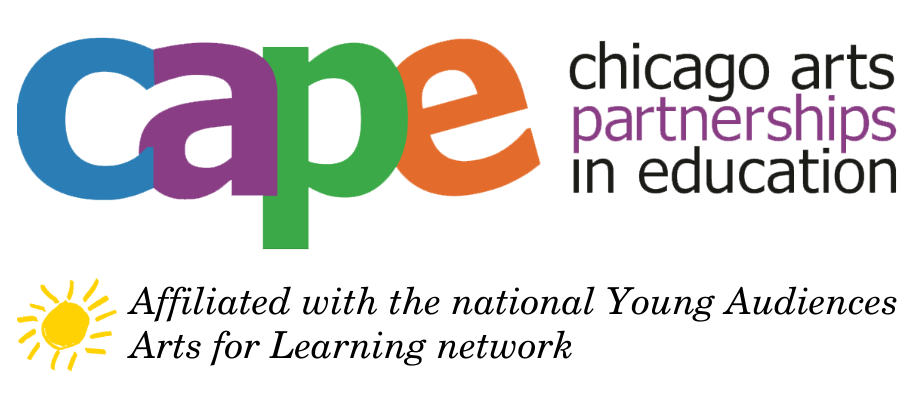Reflecting on Convergence
Convergence is our annual exhibition of student arts and learning, and it’s on right now! Click here for more details about the exhibition. This year’s exhibition is particularly special, as our Education Director, Scott Sikkema, details below.
How does this year’s Convergence fit into CAPE’s history of exhibition?
This year’s Convergence marks a return to student artwork being exhibited from the school year in which it was made. For the past few years, Convergence has featured work made in the previous school year. What viewers will see at Convergence at UIC was created in the school year 2016—2017. This is especially exciting for students who come to see the exhibit on field trips.
Showing student work from the current school year also allowed CAPE program staff to engage the teachers and artists directly in conceiving, hanging and installing the exhibition. Everything on view this year was determined by the teachers and artists who co-led the arts integrated curriculum that propelled the students in their art making.
This year is an exciting development in the Convergence exhibition and its engagement of our partnering schools, students, teachers, and artists, and of the public in general. There have been many other exciting changes over the years. Convergence began in the spring of 2003. The first Convergence was held at the CAPE office, and happened for one night only. Student artwork was not featured; instead, teachers and artists showed documentation panels of the arts integrated teaching and learning that happened in their classrooms.
Convergence then moved to a community center for a few years, was still short in duration, and continued to feature documentation panels. In 2007, we shifted to an art gallery space, and we shifted to featuring the actual artwork created in the classrooms. This also compelled curating the exhibit, and generating didactic materials to aid the public as they saw the work.
We have continued to feature the art itself since then. In 2011, primarily due to location logistics, we showed work from the previous school year, and that continued until teachers and artists at a professional development meeting in the fall of 2016 asked to again exhibit student art from the current year, and to be more directly involved in the curating. Program staff immediately responded to this, and began searching for a space to do a spring Convergence. We are happy to have settled on the Great Space at UIC for our 2017 Convergence, and we invite viewers to enjoy the results.
What does this show say about contemporary arts practice in general?
There are several currents of contemporary arts practice flowing through Convergence, all of them intertwined, rather than discrete and separate. Like much contemporary art, the art (and academics) that you see in many of the projects is interdisciplinary. An individual project may take on aspects of multiple art forms, including sculpture, installation, and performance art all in the same work, while also encompassing more than one academic content (science, math, language arts).
The form the work takes, the medium and aesthetic, is contemporary. There is nothing wrong whatsoever with traditional 2D painting, or other traditional art forms in dance, music, or theatre. That said, CAPE projects take on such forms and mediums as installation art, conceptual art, zines, postal art, video projection, conceptual photography, performance art, sound art, and more. This is also reflected in artistic examples that students look at. CAPE does not utilize a “great models” approach at all in looking at art examples from the past, but teachers, students, and artists do look at modern and contemporary examples when they need stimulation for their own investigations and ideas. (For example, once a student has seen installation art of any kind, in my experience, they are hooked and look regularly at it on their own initiative.)
Contemporary artists conduct their work as research, forming questions, conducting investigations, and putting that out in public forums. This artistic way of working and sharing has been prevalent since the post-war period. For CAPE students, teachers, and artists, it is inherent in everything they do. Like contemporary artists, CAPE partners begin by questioning the very nature of the context in which they are studying and the construct of belief around it. A classic example for me is Phil Cotton, Margy Stover, and their students asking, what is school itself.
This brings me to notions of identity, and some tensions around contemporary art. CAPE teachers and artists form a network across schools. In their classrooms, they form authentic collaborations with their students. The work they make contains questions and meaning for their sites, and then across sites when they dialogue. In this way, the work is artistic, social, dialogical, and even political. They are all artist/researchers together. This is different from some artists who identify as doing social arts practice, where they might author a public situation, usually separate from their own, let it unfold, collect the results, and transmit the results as their art work in a gallery setting, or an academic publication or conference. That way of working, to my mind, removes the vulnerability of the artist and of the collaboration itself, if it should happen in a school context. CAPE artists do not work that way (nor do the teachers or students). Instead, they are collaborating equally together, taking their chances together, and accepting a collective, reciprocal identity together as artist/researchers.
What are you most looking forward to sharing/presenting/making known to attendees at the show?
There are many things.
I would like attendees to get a sense that art, teaching/learning, and research can all function together as one.
I would like attendees to understand that CAPE as a network and as an organization has an aesthetic and a pedagogy. We have a belief system about what art is/what it means to make art, and what teaching is. Our professional developments, partnerships, and formal research correspondingly all embody this.
I would like attendees to see that there is a role for the external partner to a school that is ongoing, dialogical, collaborative, challenging, and sustainable (or should be sustainable). Many external organizations focus on plugging in a short-term way gaps at a school (i.e., they don’t have dance instruction, so let’s give it to them). But that is ultimately not a truly authentic, transforming role for an external partner. External partners should instead cause schools to think and rethink who they are, what they do, and what they believe.
I would like attendees to understand that the potential of an external partner is only reached when everyone involved is impacted, and is learning and rediscovering their vulnerability through exploring the unknown and rethinking and testing their beliefs. Therefore, CAPE itself, the artists and the program staff, must also be continuously evolving along with the schools.
I would like attendees to consider that school reform can never be dictated by a higher up authority or bureaucracy. It can only come from the classroom itself, and from networks of teachers who truly perceive themselves as a living, growing network engaged in inquiry and critical reflection.
I would like attendees to ponder, in relation to such ideas as school reform, that teaching and learning are never “solved.” Only static entities are “solved.”Because schools are not static entities, CAPE students, teachers, artists, and program staff are continuously “solving,” while moving forward to their next questions.
I would like attendees to know we are all artist/researchers together. And I invite them to become one as well.





